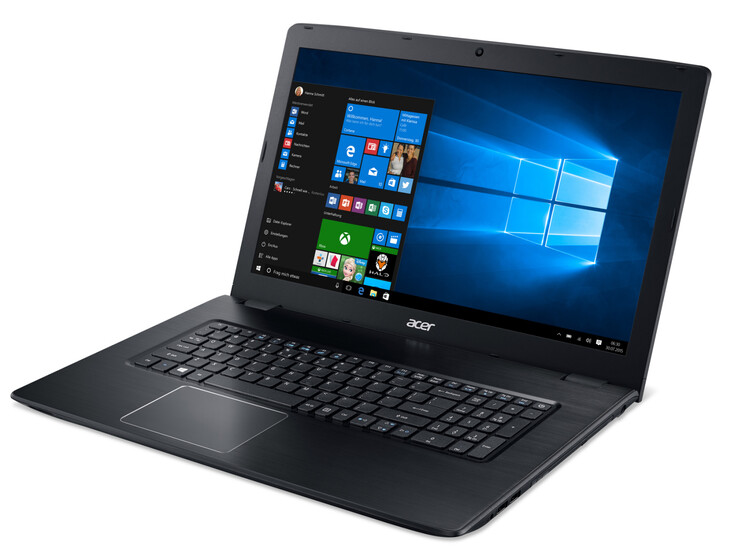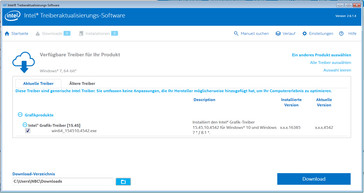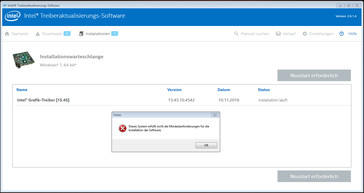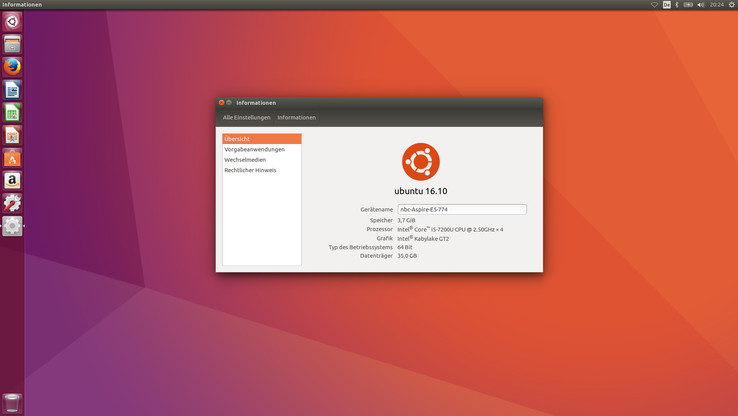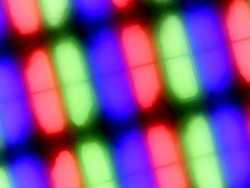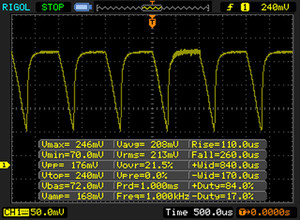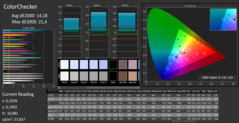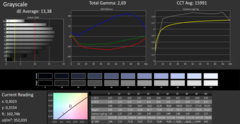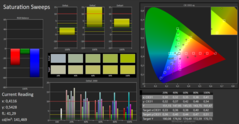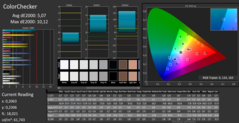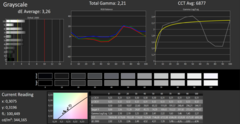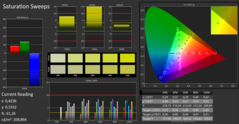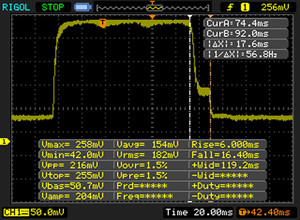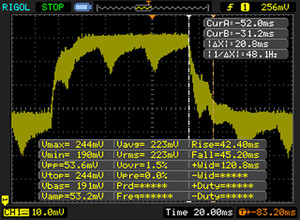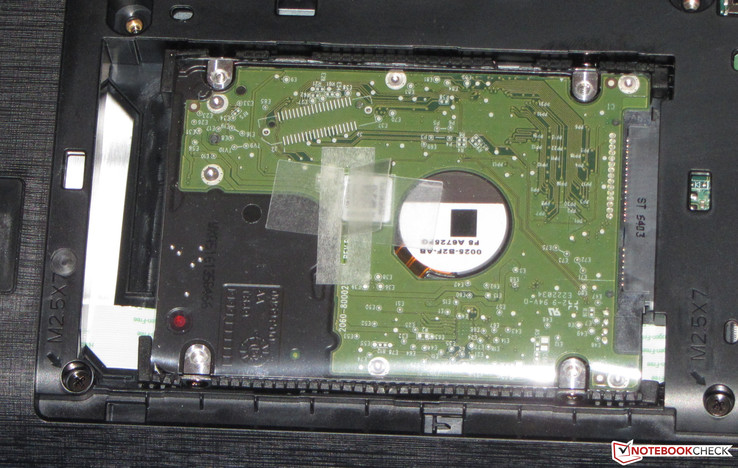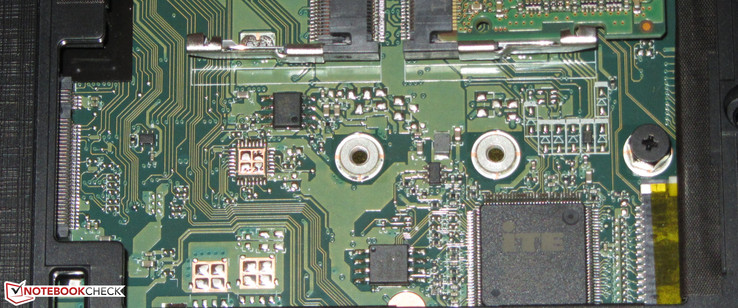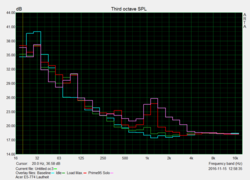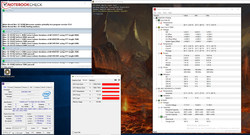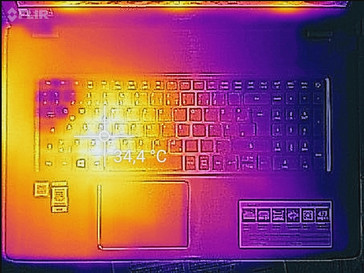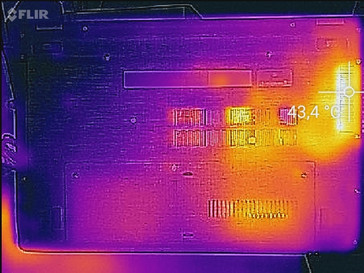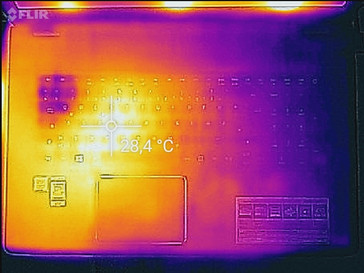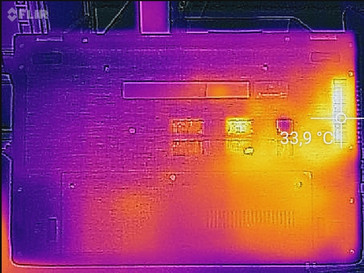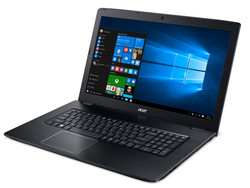Acer Aspire E5-774-54HJ Notebook Review

For the original German review, see here.
The Aspire E5-774 is a 17.3-inch office notebook, which has the same build as its sister model, the Aspire E5-774G. The latter has a dedicated GPU, whereas our test model relies only on an integrated graphics chip. The Aspire runs on a Kaby Lake processor and the competition includes laptops such as the Lenovo IdeaPad 300-17ISK, the Toshiba Satellite C70-C and the Acer Aspire ES1-731G.
Since the E5-774 and the E5-774G have the same build, we will not discuss the case, the connectivity, the input devices, the display and the speakers any further. This information can be found in the recent review of the Aspire E5-774G.
Which OS?
Our test model comes with a pre-installed copy of FreeDos. Most users will replace this installation with a Windows OS and Windows 10 is the most likely candidate, as Microsoft will not be providing Windows 7/8 support for the Kaby Lake generation. So if you are looking to install Windows 7/8, you need to rely on Intel, as they (partially) provide drivers for Windows 7/8. We tried out a Windows 7 installation on our test model.
For the first step, we added an AHCI driver of the Kaby Lake generation to the Windows 7 installation. Without this driver, the controller of the notebook cannot be recognized and by extension, neither can the hard disk. An installation would not be possible in this case. The driver can be found on the Intel website. We used the "NTLite" tool for integration. After finishing the Windows 7 installation, we found many unrecognized devices in the device manager. The installation of the chipset and the USB 3.0 drivers reduced this number significantly. Next, we installed the WLAN module using the driver provided by Acer (for Windows 7/8/10).
After finishing these tasks, we turned our attention to Windows Update, to ensure that the system had the latest updates. Sadly, no drivers were found for the hardware of the laptop. This was surprising. It is understandable that the system could not find a driver for Kaby Lake. However, it also failed to find a single driver for the common Gigabit Ethernet chip from Realtek. This chip has been on the market for years and is normally recognized and installed by Windows Update. We suspect Windows will not provide any driver support, as soon as they recognize the system is running a Kaby Lake processor on an older Windows OS. The appropriate Ethernet chip driver can be found on the Realtek website.
We finished our Windows 7 installation off by checking the functionality of the integrated graphics chip. So far, the HD Graphics 620 drivers Intel has released have all been for Windows 10 (see Readme files). Sadly, we can only use the Windows 7/8 drivers for Skylake GPUs to install our graphics chip. We hope Intel will add an appropriate Windows 7 driver to their catalog soon.
Linux is a clear alternative to Windows. We tested the 16.10 distribution of Ubuntu on our test model. Surprise: all hardware was recognized and installed correctly (including the WLAN module and the Ethernet chip). In fact, we were able to use the function keys (volume rocker, brightness adjustment) right away after the installation.
| SD Card Reader | |
| average JPG Copy Test (av. of 3 runs) | |
| Acer Aspire E5-774-54HJ | |
| Acer Aspire E5-722-662J | |
| Acer Aspire E5-774G-78NA | |
| Dell Inspiron 17 5759-5118 | |
| Lenovo IdeaPad 300-17ISK 80QH001EGE | |
| maximum AS SSD Seq Read Test (1GB) | |
| Acer Aspire E5-774-54HJ | |
| Acer Aspire E5-722-662J | |
| Acer Aspire E5-774G-78NA | |
| Lenovo IdeaPad 300-17ISK 80QH001EGE | |
| Dell Inspiron 17 5759-5118 | |
| Networking | |
| iperf Server (receive) TCP 1 m | |
| Acer Aspire E5-774-54HJ (jseb) | |
| Acer Aspire E5-774G-78NA (seb) | |
| iperf Client (transmit) TCP 1 m | |
| Acer Aspire E5-774G-78NA (seb) | |
| Acer Aspire E5-774-54HJ (jseb) | |
Display
The Aspire uses the same matte FHD screen, as its sister model, the Aspire E5-774G. As such, our measurements have remained mostly the same. However, there are slight deviations, as no two panels are exactly the same. Our test model has a bright display with good contrast and color space coverage.
| |||||||||||||||||||||||||
Brightness Distribution: 82 %
Center on Battery: 353 cd/m²
Contrast: 929:1 (Black: 0.38 cd/m²)
ΔE ColorChecker Calman: 5.07 | ∀{0.5-29.43 Ø4.77}
ΔE Greyscale Calman: 13.38 | ∀{0.09-98 Ø5}
91.6% sRGB (Argyll 1.6.3 3D)
60.1% AdobeRGB 1998 (Argyll 1.6.3 3D)
67.1% AdobeRGB 1998 (Argyll 3D)
91.7% sRGB (Argyll 3D)
71.3% Display P3 (Argyll 3D)
Gamma: 2.69
CCT: 15991 K
| Acer Aspire E5-774-54HJ TN LED, 1920x1080, 17.3" | Acer Aspire E5-774G-78NA TN LED, 1920x1080, 17.3" | Lenovo IdeaPad 300-17ISK 80QH001EGE TN LED, 1600x900, 17.3" | Acer Aspire E5-722-662J TN LED, 1600x900, 17.3" | Dell Inspiron 17 5759-5118 TN LED, 1920x1080, 17.3" | |
|---|---|---|---|---|---|
| Display | 2% | -21% | -17% | -2% | |
| Display P3 Coverage (%) | 71.3 | 72.3 1% | 52.4 -27% | 54.5 -24% | 69.3 -3% |
| sRGB Coverage (%) | 91.7 | 94.8 3% | 76.1 -17% | 81.8 -11% | 90.6 -1% |
| AdobeRGB 1998 Coverage (%) | 67.1 | 69.3 3% | 54.2 -19% | 56.1 -16% | 66.3 -1% |
| Response Times | 1% | -2% | -9% | -55% | |
| Response Time Grey 50% / Grey 80% * (ms) | 42 ? | 43 ? -2% | 42 ? -0% | 48 ? -14% | 86 ? -105% |
| Response Time Black / White * (ms) | 23 ? | 22 ? 4% | 24 ? -4% | 24 ? -4% | 24 ? -4% |
| PWM Frequency (Hz) | 1000 ? | 1000 ? | 1042 ? | 200 ? | |
| Screen | -7% | -33% | -26% | -15% | |
| Brightness middle (cd/m²) | 353 | 320 -9% | 205 -42% | 216 -39% | 304 -14% |
| Brightness (cd/m²) | 320 | 302 -6% | 182 -43% | 199 -38% | 292 -9% |
| Brightness Distribution (%) | 82 | 86 5% | 77 -6% | 80 -2% | 84 2% |
| Black Level * (cd/m²) | 0.38 | 0.4 -5% | 0.43 -13% | 0.17 55% | 0.37 3% |
| Contrast (:1) | 929 | 800 -14% | 477 -49% | 1271 37% | 822 -12% |
| Colorchecker dE 2000 * | 5.07 | 7.78 -53% | 9.75 -92% | 12.2 -141% | 10.62 -109% |
| Colorchecker dE 2000 max. * | 10.12 | 12.74 -26% | 16.02 -58% | 20.4 -102% | |
| Greyscale dE 2000 * | 13.38 | 8.87 34% | 12.09 10% | 13.3 1% | 11.78 12% |
| Gamma | 2.69 82% | 2.27 97% | 2.62 84% | 2.15 102% | 2.39 92% |
| CCT | 15991 41% | 8979 72% | 12875 50% | 15963 41% | 12997 50% |
| Color Space (Percent of AdobeRGB 1998) (%) | 60.1 | 62 3% | 49 -18% | 52 -13% | 59 -2% |
| Color Space (Percent of sRGB) (%) | 91.6 | 95 4% | 76 -17% | 76 -17% | 90 -2% |
| Total Average (Program / Settings) | -1% /
-4% | -19% /
-26% | -17% /
-22% | -24% /
-18% |
* ... smaller is better
Screen Flickering / PWM (Pulse-Width Modulation)
| Screen flickering / PWM detected | 1000 Hz | ≤ 90 % brightness setting | |
The display backlight flickers at 1000 Hz (worst case, e.g., utilizing PWM) Flickering detected at a brightness setting of 90 % and below. There should be no flickering or PWM above this brightness setting. The frequency of 1000 Hz is quite high, so most users sensitive to PWM should not notice any flickering. In comparison: 53 % of all tested devices do not use PWM to dim the display. If PWM was detected, an average of 8081 (minimum: 5 - maximum: 343500) Hz was measured. | |||
Display Response Times
| ↔ Response Time Black to White | ||
|---|---|---|
| 23 ms ... rise ↗ and fall ↘ combined | ↗ 6 ms rise | |
| ↘ 17 ms fall | ||
| The screen shows good response rates in our tests, but may be too slow for competitive gamers. In comparison, all tested devices range from 0.1 (minimum) to 240 (maximum) ms. » 51 % of all devices are better. This means that the measured response time is worse than the average of all tested devices (20.2 ms). | ||
| ↔ Response Time 50% Grey to 80% Grey | ||
| 42 ms ... rise ↗ and fall ↘ combined | ↗ 21 ms rise | |
| ↘ 21 ms fall | ||
| The screen shows slow response rates in our tests and will be unsatisfactory for gamers. In comparison, all tested devices range from 0.165 (minimum) to 636 (maximum) ms. » 66 % of all devices are better. This means that the measured response time is worse than the average of all tested devices (31.6 ms). | ||
Performance
The Acer Aspire E5-774 is a 17.3-inch office notebook, which means that it offers sufficient performance for everyday use. Our test model is available for around 550 Euros (~$583) and other configuration are available. There are also models (see Aspire E5-774G) with a dedicated GPU.
Processor
The Core i5-7200U (Kaby Lake) dual-core CPU is the heart of our test model. This is the latest Intel ULV processor (TDP: 15 W). This CPU should suffice most users and operates at a base clock speed of 2.5 GHz. Turbo allows it to jump up to 3.1 GHz (both cores) and this boost is available on battery as well.
| Geekbench 3 | |
| 32 Bit Single-Core Score | |
| Acer Aspire E5-774G-78NA | |
| Acer Aspire E5-774-54HJ | |
| Dell Inspiron 17 5759-5118 | |
| Lenovo IdeaPad 300-17ISK 80QH001EGE | |
| 32 Bit Multi-Core Score | |
| Acer Aspire E5-774G-78NA | |
| Acer Aspire E5-774-54HJ | |
| Dell Inspiron 17 5759-5118 | |
| Lenovo IdeaPad 300-17ISK 80QH001EGE | |
| Geekbench 4.0 | |
| 64 Bit Single-Core Score | |
| Acer Aspire E5-774-54HJ | |
| 64 Bit Multi-Core Score | |
| Acer Aspire E5-774-54HJ | |
| JetStream 1.1 - Total Score | |
| Acer Aspire E5-774G-78NA | |
| Acer Aspire E5-774-54HJ | |
| Lenovo IdeaPad 300-17ISK 80QH001EGE | |
| Dell Inspiron 17 5759-5118 | |
System Performance
Our test model has no Windows installation. Therefore, in order to run our tests, we chose to install Windows 10 Pro (64-bit). The system ran smoothly and we did not encounter any issues. The PC Mark benchmark results are quite good, but the system performance can be increased further by swapping out the storage device for an SSD. This will allow the system to run faster (boot times, loading programs). The HDD can stay in as the notebook has a free M.2 slot (2240, 2260, 2280). It is possible to further increase the performance by adding a second RAM module. This addition would increase the graphics performance.
| PCMark 8 Home Score Accelerated v2 | 2854 points | |
Help | ||
| PCMark 8 - Home Score Accelerated v2 | |
| Acer Aspire E5-774G-78NA | |
| Dell Inspiron 17 5759-5118 | |
| Lenovo IdeaPad 300-17ISK 80QH001EGE | |
| Acer Aspire E5-774-54HJ | |
| Acer Aspire E5-722-662J | |
Storage Device
The system drive is a 2.5-inch Western Digital HDD. It operates at 5400 RPM and offers a capacity of 500 GB. The transfer speeds of the HDD are normal for a 5400 RPM drive. The Aspire has a free M.2 slot which will accommodate appropriate SSDs.
| Acer Aspire E5-774-54HJ Western Digital Scorpio Blue WD5000LPCX-24C6HT0 | Acer Aspire E5-774G-78NA Lite-On CV1-8B256 | Lenovo IdeaPad 300-17ISK 80QH001EGE Toshiba MQ01ABD100 | Acer Aspire E5-722-662J WDC Scorpio Blue WD10JPVX-22JC3T0 | Dell Inspiron 17 5759-5118 Seagate Momentus SpinPoint M8 ST1000LM024 HN-M101MBB | |
|---|---|---|---|---|---|
| CrystalDiskMark 3.0 | 9156% | -10% | 18% | -22% | |
| Read Seq (MB/s) | 88.9 | 520 485% | 100.6 13% | 113.9 28% | 91.8 3% |
| Write Seq (MB/s) | 70.9 | 332.8 369% | 96.3 36% | 113.8 61% | 84.7 19% |
| Read 512 (MB/s) | 33.01 | 382.8 1060% | 28.15 -15% | 37.29 13% | 26.59 -19% |
| Write 512 (MB/s) | 51.6 | 357.7 593% | 43.34 -16% | 51.8 0% | 32.7 -37% |
| Read 4k (MB/s) | 0.381 | 32.31 8380% | 0.312 -18% | 0.425 12% | 0.288 -24% |
| Write 4k (MB/s) | 1.117 | 85.1 7519% | 0.792 -29% | 1.153 3% | 0.638 -43% |
| Read 4k QD32 (MB/s) | 0.891 | 277.7 31067% | 0.708 -21% | 1.095 23% | 0.59 -34% |
| Write 4k QD32 (MB/s) | 1.13 | 269.8 23776% | 0.764 -32% | 1.162 3% | 0.642 -43% |
Graphics Card
The Intel HD Graphics 620 graphics chip supports DirectX 12 and works at speeds of up to 1000 MHz. The results of the 3D Mark benchmark place the chip at the expected level. A second RAM module would activate dual-channel mode and increase the graphics performance.
| 3DMark 11 Performance | 1413 points | |
Help | ||
| 3DMark 11 - 1280x720 Performance GPU | |
| Acer Aspire E5-774G-78NA | |
| Dell Inspiron 17 5759-5118 | |
| Acer Aspire E5-774-54HJ | |
| Lenovo IdeaPad 300-17ISK 80QH001EGE | |
| Acer Aspire E5-774-54HJ | |
| Acer Aspire E5-722-662J | |
Gaming Performance
The test model runs many games smoothly. However, it is best-suited for games with modest requirements. These games are best run with low resolutions and details to reach a smooth FPS. A second RAM module would increase the performance (=Dual-Channel mode active). Power hungry games, such as “Mafia 3”, are not going to run well on this notebook, as they need higher performance.
| low | med. | high | ultra | |
|---|---|---|---|---|
| BioShock Infinite (2013) | 35.6 | 20.1 | 16.6 | 5.4 |
| BioShock Infinite - 1280x720 Very Low Preset | |
| Acer Aspire E5-774G-78NA | |
| Acer Aspire E5-774-54HJ | |
| Dell Inspiron 17 5759-5118 | |
| Lenovo IdeaPad 300-17ISK 80QH001EGE | |
| Acer Aspire E5-774-54HJ | |
Emissions and Energy
System Noise
The Aspire barely makes any noise. While idle, the fan is often off and we could hear the HDD running. If you swap the HDD for an SSD, you could even have a silent laptop. Under load, the fan barely turns up. We measured a maximum emission of 33.8 dB(A), which is very good. Unfortunately, the fan emits a whirring noise.
Noise level
| Idle |
| 30.8 / 30.8 / 30.8 dB(A) |
| HDD |
| 32.4 dB(A) |
| DVD |
| 35.6 / dB(A) |
| Load |
| 32.1 / 33.8 dB(A) |
 | ||
30 dB silent 40 dB(A) audible 50 dB(A) loud |
||
min: | ||
Temperature
Our stress test (Prime95 and FurMark run simultaneously for at least an hour) runs the same way on the Aspire whether it is on battery or plugged in. The CPU runs at 3.1 GHz and the integrated graphics chip operates at 1000 MHz. The laptop barely heats up: during our stress test, we measured two points at which the laptop exceeds the 30 degrees Celsius (~86 degrees Fahrenheit) mark.
(+) The maximum temperature on the upper side is 30.4 °C / 87 F, compared to the average of 34.3 °C / 94 F, ranging from 21.2 to 62.5 °C for the class Office.
(+) The bottom heats up to a maximum of 30.6 °C / 87 F, compared to the average of 36.8 °C / 98 F
(+) In idle usage, the average temperature for the upper side is 24.9 °C / 77 F, compared to the device average of 29.5 °C / 85 F.
(+) The palmrests and touchpad are cooler than skin temperature with a maximum of 28.8 °C / 83.8 F and are therefore cool to the touch.
(±) The average temperature of the palmrest area of similar devices was 27.6 °C / 81.7 F (-1.2 °C / -2.1 F).
Acer Aspire E5-774-54HJ audio analysis
(±) | speaker loudness is average but good (79 dB)
Bass 100 - 315 Hz
(-) | nearly no bass - on average 24.9% lower than median
(±) | linearity of bass is average (10.6% delta to prev. frequency)
Mids 400 - 2000 Hz
(+) | balanced mids - only 4.4% away from median
(±) | linearity of mids is average (10.7% delta to prev. frequency)
Highs 2 - 16 kHz
(+) | balanced highs - only 4.4% away from median
(+) | highs are linear (5.1% delta to prev. frequency)
Overall 100 - 16.000 Hz
(±) | linearity of overall sound is average (24.7% difference to median)
Compared to same class
» 72% of all tested devices in this class were better, 7% similar, 20% worse
» The best had a delta of 7%, average was 21%, worst was 53%
Compared to all devices tested
» 75% of all tested devices were better, 5% similar, 20% worse
» The best had a delta of 4%, average was 24%, worst was 134%
Apple MacBook 12 (Early 2016) 1.1 GHz audio analysis
(+) | speakers can play relatively loud (83.6 dB)
Bass 100 - 315 Hz
(±) | reduced bass - on average 11.3% lower than median
(±) | linearity of bass is average (14.2% delta to prev. frequency)
Mids 400 - 2000 Hz
(+) | balanced mids - only 2.4% away from median
(+) | mids are linear (5.5% delta to prev. frequency)
Highs 2 - 16 kHz
(+) | balanced highs - only 2% away from median
(+) | highs are linear (4.5% delta to prev. frequency)
Overall 100 - 16.000 Hz
(+) | overall sound is linear (10.2% difference to median)
Compared to same class
» 7% of all tested devices in this class were better, 2% similar, 91% worse
» The best had a delta of 5%, average was 18%, worst was 53%
Compared to all devices tested
» 4% of all tested devices were better, 1% similar, 94% worse
» The best had a delta of 4%, average was 24%, worst was 134%
Frequency diagram for comparison (checkboxes above can be selected!)
Power Consumption
While idle, we measure a consumption rate of 10.5 watts, which is a normal value for a 17.3-inch notebook. During our stress test, this number rose to 37 watts (max.). CPU and GPU work at full speed and the power adapter is adequately scoped with a capacity of 65 watts.
| Off / Standby | |
| Idle | |
| Load |
|
Key:
min: | |
Battery Life
In our WLAN test, we simulate the load when surfing various websites. The power profile is set to "Balanced" and the power saver functions of the laptop are turned off. The brightness is regulated to around 150 cd/m². The laptop runs for 5:20 hours, which is quite good for a 17.3-inch notebook.
| Battery Runtime - WiFi Websurfing | |
| Lenovo IdeaPad 300-17ISK 80QH001EGE | |
| Acer Aspire E5-774G-78NA | |
| Acer Aspire E5-774-54HJ | |
| Dell Inspiron 17 5759-5118 | |
| Acer Aspire E5-722-662J | |
Pros
Cons
Verdict
The Core i5 processor of the Kaby Lake generation offers sufficient performance for everyday tasks and the integrated graphics chip will run a lot of games (with modest requirements). We recommend installing a second RAM module to increase the system and graphics performance. The laptop is quiet and barely heats up. The storage space of 500 GB is quite good, but we recommend installing an M.2 SSD in the empty slot of the notebook. Thanks to the maintenance flap, the user will be able to perform this operation easily. The keyboard of the laptop is quite good and the battery life is decent for a 17.3-inch model. The matte, bright FHD panel has strong contrast, but suffers from poor viewing angles since it is a TN panel. However, this is one of the better TN panels available, which means that at least it has wider viewing angles than a cheaper, standard TN screen. Sadly, it will not be able to compete with an IPS panel.
The Aspire E5-774 is a well-designed notebook for home office use.
If you like this laptop, but want more graphics performance, we would advise you to take a look at the Aspire E5-774G. The E5-774G offers a dedicated GeForce 940MX GPU with GDDR5 memory. This combination will produce 20-30% higher frame rates than a notebook with a GeForce 940MX and GDDR3 memory.
Acer Aspire E5-774-54HJ
- 11/20/2016 v5.1 (old)
Sascha Mölck


